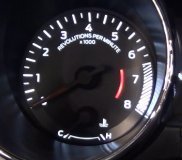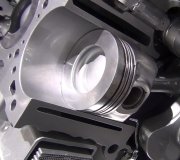Front wheel bearings make a buzzing noise, like an airplane engine, when they become noisy. Also, GM has a real lot of repeat bearing failure in as little as 15,000 miles, where the bearing develops a little play, which is otherwise normal and harmless, but if your car has anti-lock brakes, that play causes the wheel speed sensors to stop generating a signal. Either the yellow "ABS" warning light will turn on, or the ABS system will kick in at lower speeds when it is not needed.
If all you have is a buzzing noise, the fix is to replace the noisy bearing, but that can be misleading too. What sounds like a noisy left bearing can actually be caused by the right one. The noise can transfer to the other side.
With some pressed-in bearings on older cars, you can get a clue to which is the noisy one by turning slightly, as in when changing lanes. When you turn slightly to the left, the noise will stop if it is the left bearing that is noisy. That is because doing so shifts much of the vehicle's weight off that bearing. Your car uses a bolt-on bearing assembly, and turning usually does not provide that clue. Those cost a lot more than pressed-in bearings, but they are easier to replace.
There are two ways to verify you are replacing the correct bearing. I prefer to run the engine, in gear, on a hoist, then I listen next to each one with a stethoscope. You will hear the rumbling from the noisy one. You can also raise the front wheels off the ground, shift the transmission into "neutral", reach over the top of a tire and wrap your fingertips around part of the coil spring, then feel for the vibration as you rotate the wheel by hand.
All front wheel bearings of this type are sealed. There is nothing to grease, and if you could, grease is not going to solve this problem. There are indentations in the "race" the bearings ride on. You are hearing the mechanical rumbling as the marbles run over those indentations.
Also be aware the biggest cause of repeat bearing failure, other than GM's ABS problem, is failure to tighten the axle nut to specification before placing any vehicle weight on it. When the car is set on the ground to hold the wheel/axle from turning, so the nut can be tightened, it is too late. At that point the bearing has already been damaged and will be noisy.
As far as dollars, a noisy bearing is not a safety hazard if your car does not have anti-lock brakes, and they can last a long time like that. If you can stand the noise, you do not have to replace the bearing right away.
Sunday, June 25th, 2017 AT 2:23 PM


